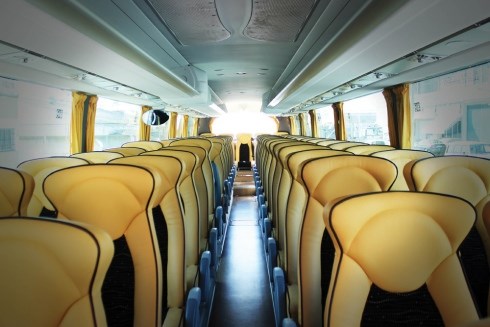With Greyhound having made its last stop in Squamish this week, companies and local leaders are looking to what is next to fill the bus line’s void.
Effective Oct. 31 at 11:59 p.m., Greyhound stopped all service within Canada except Ontario and Quebec.
In the Sea to Sky Corridor, the last bus departed Whistler at 5 p.m. Halloween night.
The depot on 40446 Government Road in Squamish’s North Garibaldi, which is independently owned, will shut down.
The local drivers have lost their jobs upon the termination of service, according to a spokesperson for Greyhound.
The company announced its decision to discontinue western Canada routes for financial reasons on July 9.
“Bus passenger transport has been challenged by many factors, including declining ridership in rural communities; increased competition from subsidized national and inter-regional passenger transportation services; the entry of ultra-low-cost carriers; regulatory constraints and increased car travel,” Greyhound posted on its website.
Ridership with Greyhound dropped nearly 41 per cent across the country since 2010, according to the company.
But people in the corridor still need to get up and down the highway so it is reasonable to think more options for pickups and drop-offs would be welcomed by many locals.

Why something is needed to replace Greyhound
Lisa Young, homeless prevention and outreach worker with Sea to Sky Community Services, previously told The Chief her organization supplied clients with Greyhound tickets for accessing services out of the community.
That can include everything from dental services to attending court appointments.
In addition to transit to Vancouver, clients also rely on buses to access treatment and recovery centres for addictions or getting CT scans in Whistler.
“It will significantly affect our clients,” said Young, when the cuts were announced. “We don’t know what to do, but I’m hoping something else comes in. It sounds like lots of people are trying to find different solutions.”
Chief Dean Nelson of the Líl’wat Nation said members of his nation used Greyhound to get to employment up and down the corridor.
“There are concerns for everybody… having a more viable transportation system — a dependable one.”
The best option would be a public, regional transit system, he said. “Something in a smaller scale [than Greyhound] that is put in place for the needs of the workers.”
The provincial government announced Monday that by the end of the year, 83 per cent of the routes that were abandoned by Greyhound will be picked up by other private operators.
Victoria and the Passenger Transportation Board implemented a fast-tracked application process to replace Greyhound when it announced it would be stopping service.
However, Sea to Sky MLA and transportation critic Jordan Sturdy questions the NDP-Green government’s stance.
“I would like Transportation Minister Claire Trevena to release the data that arrives at the conclusion of 83 per cent coverage throughout the province,” Sturdy said in a news release on Monday. “It’s all very well to look at the total length of highway being used by combined operators, but what really counts is what communities are actually being served and how often.”
We’ve heard your concerns about the lack of inter-city bus service when #Greyhound discontinues operations at the end of October. Today, we’re announcing the government’s next steps. #BC pic.twitter.com/WNOnsR6Fx9
— Claire Trevena (@clairetrevena) October 29, 2018
Jockeying for position
Several companies are vying for a piece of the Sea to Sky passenger pie.
Squamish Connector has launched an online survey to assess the needs of locals.
“The survey is to find out what times and departures people need,” the company’s Felipe Angel said. “And what is it feasible to do.”
So far, the survey has shown people want the bus to stop at Garibaldi Village and more stops at the Chieftain Hotel, downtown.
The company currently focuses on the needs of people leaving Squamish who want to get to Vancouver or Whistler.
Squamish Connector is applying to the Passenger Transportation Board for an inner-city license, Angel said.
“What that allows us to do is stop throughout the municipality.”
Currently, the company’s license only allows it to go from point A to point B without any stops in between.
Information from the survey is helping to inform their future plans and their current application, Angel said.
Go to www.surveymonkey.com/r/squamishconnectorsm to take the short survey.
If they are able to tap into it, local companies should gain not only from Greyhound ending its service, but from locals who may want to get out of the car for their commute.
Recent Statistics Canada numbers show 53 per cent of Squamish residents commute more than 15 minutes to get to work.
The vast majority of Squamish’s workforce gets to the job in a personal vehicle — about 8,200 of the 9,620 people who commute, according to census data.
Contrail Coach Lines is waiting on their application for an inter-city bus license to add a Vancouver-to-Pemberton route.
“In replacing Greyhound, Contrail believes that there exists an opportunity to expand its scheduled bus service from Seattle to Vancouver and then to Whistler and Pemberton,” its application reads.
A request for an interview with the principal at Contrail was not responded to by press deadline.
The Island Connector also has an application to amend its special authorization to add a route from Vancouver to Whistler.
Whistler Rides has applied to add Vancouver to Pemberton to its routes.
“We thought that Pemberton should be joined with Squamish, and they should also be able to stop at Horseshoe Bay if they are going to take a ferry,” said the company’s principal Venustiano Figueroa Carranza.
Wilson’s Transportation has a decision pending on a request to add a Vancouver- to-Whistler route to its offering, which are currently focused on routes between the city and the Interior.
Snow Bus, (official name, Blue Cactus Coach Lines) has an inter-city application to add UBC and Squamish as route points from Richmond to Whistler — with reservation service only — and on its Burnaby to Whistler routes to add Squamish as a passenger drop-off location on northbound trips and as a pick up on southbound trips.
Snow Bus is the longest standing bus operator for Whistler, according to the company’s Joktan Elbert. “Our business model is, we take people to and from ski resorts,” he said, adding Squamish is a no-brainer for the company.
“We go past Squamish and if we can offer a seat or two or 10, or whatever, we are happy to do that,” he said. “And we will make that stop if there is a reservation.”
He said a concern is that with so many applications to operate transportation services through the corridor, if all are accepted, it could create a negative situation for transport owners and ultimately riders. “Is the government going to continue to award licensing a corridor that is well-serviced… or are they going to let current operators serve the route and allow them to grow and improve service?”
Elbert worries that if too many companies are operating at once, it will be too competitive, safety could go down as companies try to cut fees and ultimately companies may not survive, leaving travellers scrambling once again.
Outgoing Mayor Patricia Heintzman agrees that it is a tricky balance adding enough service without saturating the corridor.
“The Passenger Transportation Board has a bit of a challenging job in that they want to create enough competition that it helps bring prices to the point it is affordable, but at the same time there’s a threshold and you could make everybody fail.”
Heintzman also wondered if any of the companies could get the price point down on their offerings to the point it would be a viable option for local commuters.

What can the District do to help?
Though a few companies mentioned they were hoping for some sort of District subsidization, mayor-elect Karen Elliott said that direct subsidies for these companies wouldn’t be possible as it is against provincial legislation for the District to provide financial support to a business.
“However, we do play a role in understanding where private operators want to pick up and drop off, to ensure facilities are adequate over the long term. We have also written letters to the Passenger Transportation Board to encourage the timely processing of applications for service.”
Heintzman said specific services could be put out as a District request for proposal (RFP): for example, for transportation to hospitals in the Lower Mainland, but agreed with Elliott that the new council would have to tread carefully. Transportation is very expensive, she noted.
“Council needs to be very careful about how much this is going to cost them and is this going to undermine a future regional transit system, or not,” she said.
“It could be a serious expenditure for local government and I think you then want to start talking about how much do local taxpayer dollars go into subsidizing inter-regional transit.”
The current financial plan would have to be amended by the new council for any extra transit considerations, Heintzman noted.
“We can’t just fabricate money out of nothing. We have collected taxes, approved the financial plan and we would have to amend the five-year financial plan if council was going to do that.”
Transit will be the most immediate challenging issue the fresh council will have to address, Heintzman said.

Regional transit?
Elliott said she expects both public transit as well as private companies will fill in for Greyhound.
“We’re working with our local government partners and two First Nations on a regional transit solution, but the earliest it would launch is the fall of 2019,” Elliott said.
The regional transit plan would extend bus service from Mount Currie down to the Lower Mainland and involve the local governments and First Nations up and down the corridor.
Heintzman said the timeline targets to meet the 2019 regional transit deadline are tight, but still the goal.
“The trick is figuring out a system of paying for that, that doesn’t dramatically impact local property taxes and that could be a variety of different funding mechanisms,” she said. “And how do we pay for that? Is it through a motor fuel tax, is it through purely property tax? If it is through purely property tax, that is a lot to local government — you think of Pemberton and how small their budget is, or the SLRD’s.”
Editor’s note: The Chief requested to talk to someone at Pacific Coach Lines and Universal Coach Lines, who are players in the Sea to Sky Corridor, but we were unable to get a comment from these companies by press deadline. The Squamish Nation, which is a stakeholder in the regional transit discussion, also did not respond by press deadline.
~With files from Steven Chua and Haley Ritchie
Fast facts
There are two types of licences within the Passenger Transportation Act.
Those who operate commercial passenger vehicles in B.C. need a passenger transportation licence issued under the act, and the Passenger Transportation Regulation.
The Passenger Transportation Act sets out:
• Two types of passenger transportation licence authorization:
1. special authorization
2. general authorization
• Three types of commercial passenger vehicles:
1. passenger-directed vehicles
2. inter-city buses
3. general passenger vehicles
The type of passenger transportation licence required will depend on:
• the type(s) of commercial passenger vehicle used
• the service(s) provided
The following vehicles and services require a Special Authorization Licence:
• Inter-city buses, such as vehicles providing scheduled services.
• Passenger-directed vehicles, such as taxis, limousines and small shuttle buses or other passenger-type vehicles with a carrying capacity of 11 passengers or less, excluding the driver, or any size of vehicle with primarily perimeter seating.
• Vehicles and services requiring special authorization must obtain approval from the Passenger Transportation Board and are considered on the basis of the three-part test set out in the act.
If the Board approves an application for special authorization, the applicant must demonstrate to the registrar of passenger transportation that they have met all safety requirements before a licence can be issued.
The following vehicles and services require a General Authorization Licence:
• General passenger vehicles such as charter buses or other types of vehicles with forward facing seats designed to carry 12 passengers or more, excluding the driver.
• Vehicles designed to carry 11 passengers or less, excluding the driver, or perimeter seating vehicles.
Examples of General Passenger Vehicles include:
* Tour or charter or sightseeing buses with primarily forward facing seats that have a carrying capacity of a driver and 12 or more passengers. (These may be carrier- directed or passenger-directed services.)
* Sightseeing buses if the operator sets all itineraries. (These are carrier-directed tours. Trips are not customized for passengers. Operators may use vehicles with a carrying capacity of a driver and 11 passengers or fewer.)
* Tour operations if the operator sets all tours. (These are carrier-directed tours. Trips are not customized for passengers.)
Vehicles and services requiring general authorization must obtain approval from the registrar of passenger transportation. If the registrar is satisfied that the proposed service appears to meet the criteria for a general authorization, the applicant must demonstrate that they have met all the safety requirements before a licence can be issued.



